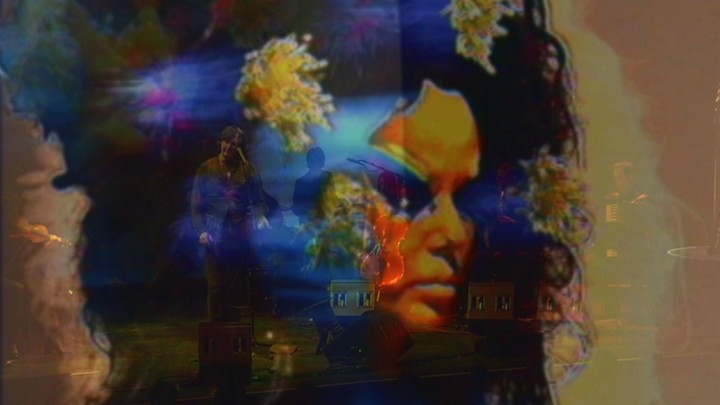It can be difficult to separate the work of Charles Atlas from that of his subjects: for four decades, he’s guided a spotlight onto other artists, choreographers and personalities by documenting their practices — and sometimes merely their presences.
For several days in March, “ATLAS IN LA,” a multifaceted program of screenings and talks organized by Los Angeles artist Paul Pescador, spread across venues including the Los Angeles Film Forum, the Hammer Museum and Cal Arts, provides a long-overdue West Coast survey. Authoring influential dance-for-camera experiments and technology-driven video portraits, the artist is unambiguous in his own styling, constructing documentary from fiction, script and theater.
Atlas slides his camera between two and three dimensions, pioneering the spliced medium of videodance. Filming performances choreographed specifically for the screen, these works are unable to rely on the excitement that physical proximity provides in live work; rather, they transmit their energy through the projector, flattening experience into a low-resolution square.
Mostly, he’s collaborated with his friends. After working as the Merce Cunningham Dance Company’s filmmaker in residence beginning in 1978, the two made Blue Studio: Five Segments (1975–76); their relationship was bookended by Merce Cunningham: A Lifetime of Dance (2001). In 1984, he established an ongoing relationship with the Michael Clark Company. British choreographer Clark’s productions incorporating graphic fashion and popular music are as contemporary and accessible as Merce Cunningham’s slow, sweeping movements are abstract and Minimalist. They made Hail to the New Puritan (1986), a parody of a made-for-television sketch that followed Clark around to show the public a typical day in the life of a modern choreographer. The buoyant, tongue-in-cheek piece was screened at nonprofit Chinatown space Human Resources as part of the evening program “Charles Atlas: Dance! Dance! Dance!” along with companion piece Ex-Romance (1987).
A night at the historic ONE National Gay & Lesbian Archives at the USC Libraries was dedicated to queer icon Leigh Bowery. “Charles Atlas: Leigh Bowery and Friends” rounded up the feature-length documentary The Legend of Leigh Bowery (2001), contextualizing the notorious downtown personality, a nightlife legend who was rarely spotted anywhere before midnight. Marked as an immoral freak by the mainstream in the heated AIDS-scare late 1980s, the story of the mythic and misaligned character is told through anecdotes from his immediate family in Australia; his close confidant and eventual wife, Nicola Bateman; and artists for whom Leigh was a constant muse, including painter Lucien Freud and fashion designer Alexander McQueen. Atlas’s ongoing support for and fascination with Bowery resulted in the experimental short film Ms. Peanut Visits New York (1999), a snippet of Leigh navigating the cobblestone streets of New York’s still-dodgy west side in high heels and an impossible costume, and Dizzy Remix (2008), a multi-screen installation made for Kunstverein Hannover.
Within a more traditional film format, the artist’s work culminates in the grand, ambitious Ocean (1994). At the bottom of Rainbow Granite Quarry in Minnesota, the artist, joined by a five-person film crew, documented the Merce Cunningham Company performing to the music of a 150-member live orchestra before an audience of 4,500. He skipped generations again for the touching, emotional TURNING (2012), a concert film made together with Antony, following a European concert tour by Antony & the Johnsons. Interspersed among performance footage of the group are video portraits of thirteen women who uniquely define femininity — among them Kembra Pfahler, Cinema of Transgression actress and lead singer of The Voluptuous Horror of Karen Black; transgender DJ Honey Dijon; and underground performance artist Johanna Constantine, taking the stage in her signature look of caked blood and twisted wires — all take turns both “turning” on a rotating platform onstage as well as backstage for a moving, intimate interview.
Adjoining the screening program is a group exhibition at Park View gallery. Titled “A New Rhythm,” the show clusters Atlas with Benjamin Carlson, Nancy Lupo and Silke Otto-Knapp, all illustrating motion in ways other than moving gestures. Videos Fractions I (1978, with Merce Cunningham) and Jump (1984, with Philippe Decouflé) loop on one wall, wobbling between the grainy black-and-white footage of Cunningham and the latter’s acid-bright new-wave dramas cut by stylistic edits and sharply cadenced moves, more resembling a pop music video than fine art choreography. The achromatic Fractions I is directly reflected across the room by Otto-Knapp’s gray-scale canvas Seascape (third movement) (2013); in the same palette, Nancy Lupo’s floor sculpture Tuxedo Feeder (2014), an abstract sofa form of black and white quinoa and epoxy, three-dimensional but smoothly rounded, completes this gray-scale triangle. The fuchsia and teal melodrama on view in Jump bounces to Benjamin Carlson’s jumpy cobalt and indigo square hiding around the corner, scattered in aquamarine triangles that circulate incomplete with visible nervous energy, a visually hypnagogic pop work from 2015.
Watching videos stacked one on top of another throughout the city reveals how many time capsules the artist has created. Standing as the living record of so many historic live performances and turning points in visual culture, the various films richly flesh out deflated screen images, eagerly received in any space with room for the new.

